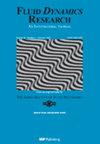波状前缘机翼在亚音速和跨音速气流中的失速特性
IF 1.3
4区 工程技术
Q3 MECHANICS
引用次数: 0
摘要
基于生物启发的波浪形前缘,对 NACA0012 机翼的失速特性进行了优化。本文采用半圆加线段的方法获得波浪形前缘。通过高精度天平测量了机翼的气动力,并通过油流试验获得了机翼的详细流动特征。然后,结合数值模拟,得到了优化机制。运行条件如下马赫数从 0.4 到 0.8,攻角从 -4° 到 25°。结果表明,在高速气流中,与基本翼面相比,波浪形前缘翼面的升力系数并不随攻角的增大而急剧下降,波浪形前缘翼面的阻力系数与基本翼面相近;在所研究的三种翼面中,波浪形前缘特征尺寸较大的翼面具有更好的气动特性;结合数值模拟结果可以看出,不同马赫数下翼面的失速机理各不相同。波浪形前缘会产生流向涡流。流向涡流增加了边界层的能量传输。因此,分离区向机翼后缘移动,机翼的失速特性得到优化。本文章由计算机程序翻译,如有差异,请以英文原文为准。
Stall characteristics of wavy leading-edge airfoil in subsonic and transonic airflows
Based on the bioinspired wavy leading-edge, the stall characteristics of the NACA0012 airfoil are optimized. In this paper, the semicircle plus line segment is used to obtain the wavy leading edge. The aerodynamic forces of the airfoil are measured by a high-precision balance, and the detailed flow features of the airfoil are obtained by the oil flow tests. Then, combined with numerical simulation, the optimization mechanism is obtained. The operating conditions are as follows: Mach number ranging from 0.4 to 0.8, and angle of attack ranging from −4° to 25°. The results show that in high speed airflows, compared with the basic airfoil, the lift coefficient of the wavy leading-edge airfoil does not decrease sharply with the increase of the angle of attack, and the drag coefficient of the wavy leading-edge airfoil is similar to the basic airfoil; among the three types of airfoils studied, the larger wavy leading-edge feature size has better aerodynamic characteristics; combined with the numerical simulation results, it can be seen that the stall mechanism of airfoils varies at different Mach numbers. The wavy leading-edge generate streamwise vortex. The streamwise vortices increase energy transport in the boundary layer. Therefore, the separation zone moves toward the trailing edge of the airfoil, and the stall characteristics of the airfoil are optimized.
求助全文
通过发布文献求助,成功后即可免费获取论文全文。
去求助
来源期刊

Fluid Dynamics Research
物理-力学
CiteScore
2.90
自引率
6.70%
发文量
37
审稿时长
5 months
期刊介绍:
Fluid Dynamics Research publishes original and creative works in all fields of fluid dynamics. The scope includes theoretical, numerical and experimental studies that contribute to the fundamental understanding and/or application of fluid phenomena.
 求助内容:
求助内容: 应助结果提醒方式:
应助结果提醒方式:


